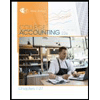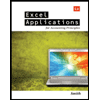
1-(a)
Journalize the entry for the issuance of bonds in the books of Incorporation B.
1-(a)
Explanation of Solution
Bonds: Bonds are the financial debt instruments issued by the corporations to raise capital for the purposes of purchasing assets, or paying debts. Bonds are bought by individual investors, or corporations, or mutual funds, and receive a fixed interest revenue.
Debit and credit rules:
- Debit an increase in asset account, increase in expense account, decrease in liability account, and decrease in
stockholders’ equity accounts. - Credit decrease in asset account, increase in revenue account, increase in liability account, and increase in stockholders’ equity accounts.
Journalize the entry for the issuance of bonds in the books of Incorporation B.
| Date | Account Titles and Explanation | Post Ref. | Debit ($) | Credit ($) | ||
| 20-1 | ||||||
| April | 1 | Cash | 576,000 | |||
| Discount on Bonds Payable | 24,000 | |||||
| Bonds Payable | 600,000 | |||||
| (Record issuance of bonds at discount) | ||||||
Table (1)
Description:
- Cash is an asset account. The amount is increased because cash is received from the bond issue, and an increase in assets should be debited.
- Discount on Bonds Payable account is a contra-liability account, the account which decreases the balance of the respective liability account. Therefore, the respective liability account is decreased, and a decrease in liability is debited.
- Bonds Payable is a liability account. Since the liability to pay bonds has increased, liability increased, and an increase in liability is credited.
Working Notes:
Compute the amount of cash received.
Compute the amount of discount on bonds payable (unamortized discount).
Note: Refer to Equation (1) for value and computation of cash received.
(b)
Journalize the entry for the semiannual interest payment and discount amortization in the books of Incorporation B.
(b)
Explanation of Solution
Journalize the entry for the semiannual interest payment and discount amortization in the books of Incorporation B.
| Date | Account Titles and Explanation | Post Ref. | Debit ($) | Credit ($) | ||
| 20-1 | ||||||
| September | 30 | Bond Interest Expense | 22,200 | |||
| Discount on Bonds Payable | 1,200 | |||||
| Cash | 21,000 | |||||
| (Record payment of semiannual interest and the amortization of discount) | ||||||
Table (2)
Description:
- Bond Interest Expense is an expense account. Expenses reduce the stockholders’ equity account, and a decrease in equity is debited.
- Discount on Bonds Payable account is a contra-liability account, the account which decreases the balance of the respective liability account. Since the discount is amortized, the discount value is reduced, and a decrease in contra-liability is credited.
- Cash is an asset account. The amount is decreased because cash is paid, and a decrease in assets should be credited.
Working Notes:
Compute the cash paid.
Compute the amount of amortized discount.
Note: Refer to Equation (2) for value and computation of unamortized discount.
Compute the amount of bond interest expense.
Note: Refer to Equation (3) and (4) for both the values.
(c)
Journalize the entry for the year-end adjustment in the books of Incorporation B.
(c)
Explanation of Solution
Journalize the entry for the year-end adjustment in the books of Incorporation B.
| Date | Account Titles and Explanation | Post Ref. | Debit ($) | Credit ($) | ||
| 20-1 | ||||||
| December | 31 | Bond Interest Expense | 11,100 | |||
| Discount on Bonds Payable | 600 | |||||
| Bond Interest Payable | 10,500 | |||||
| (Record interest expense accrued) | ||||||
Table (3)
Description:
- Bond Interest Expense is an expense account. Since the interest is accrued, the interest expense increased. Expenses reduce the stockholders’ equity account, and a decrease in equity is debited.
- Discount on Bonds Payable account is a contra-liability account, the account which decreases the balance of the respective liability account. Since the discount is amortized, the discount value is reduced, and a decrease in contra-liability is credited.
- Bond Interest Payable is a liability account. Since the liability to pay interest has increased, liability increased, and an increase in liability is credited.
Working Notes:
Compute the accrued bond interest payable amount.
Compute the amount of amortized discount.
Note: Refer to Equation (2) for value and computation of unamortized discount.
Compute the amount of bond interest expense.
Note: Refer to Equations (6) and (7) for both the values.
(d)
Journalize the entry to reverse the year-end adjustment in the books of Incorporation B.
(d)
Explanation of Solution
Journalize the entry to reverse the year-end adjustment in the books of Incorporation B.
| Date | Account Titles and Explanation | Post Ref. | Debit ($) | Credit ($) | ||
| 20-2 | ||||||
| January | 1 | Bond Interest Payable | 10,500 | |||
| Discount on Bonds Payable | 600 | |||||
| Bond Interest Expense | 11,100 | |||||
| (Record reversing entry for the accrued interest expense) | ||||||
Table (4)
Description:
- Bond Interest Payable is a liability account. Since the entry is reversed, liability which was credited earlier is debited now.
- Discount on Bonds Payable account is a contra-liability account, the account which decreases the balance of the respective liability account. Since the entry is reversed, the liability which was credited earlier is debited now.
- Bond Interest Expense is an expense account. Since the entry is reversed, the stockholders’ equity which was debited earlier is credited now.
Note: Refer to Equations (6), (7), and (8) for the computation of all values.
(e)
Journalize the entry for the semiannual interest payment and discount amortization for 20-2, in the books of Incorporation B.
(e)
Explanation of Solution
Journalize the entry for the semiannual interest payment and discount amortization in the books of Incorporation B, on September 30.
| Date | Account Titles and Explanation | Post Ref. | Debit ($) | Credit ($) | ||
| 20-2 | ||||||
| September | 30 | Bond Interest Expense | 22,200 | |||
| Discount on Bonds Payable | 1,200 | |||||
| Cash | 21,000 | |||||
| (Record payment of semiannual interest and the amortization of discount) | ||||||
Table (5)
Description:
- Bond Interest Expense is an expense account. Expenses reduce the stockholders’ equity account, and a decrease in equity is debited.
- Discount on Bonds Payable account is a contra-liability account, the account which decreases the balance of the respective liability account. Since the discount is amortized, the discount value is reduced, and a decrease in contra-liability is credited.
- Cash is an asset account. The amount is decreased because cash is paid, and a decrease in assets should be credited.
Note: Refer to Equations (3), (4), and (5) for both the values.
Journalize the entry for the semiannual interest payment and discount amortization in the books of Incorporation B, on September 30.
| Date | Account Titles and Explanation | Post Ref. | Debit ($) | Credit ($) | ||
| 20-2 | ||||||
| September | 30 | Bond Interest Expense | 22,200 | |||
| Discount on Bonds Payable | 1,200 | |||||
| Cash | 21,000 | |||||
| (Record payment of semiannual interest and the amortization of discount) | ||||||
Table (6)
Description:
- Bond Interest Expense is an expense account. Expenses reduce the stockholders’ equity account, and a decrease in equity is debited.
- Discount on Bonds Payable account is a contra-liability account, the account which decreases the balance of the respective liability account. Since the discount is amortized, the discount value is reduced, and a decrease in contra-liability is credited.
- Cash is an asset account. The amount is decreased because cash is paid, and a decrease in assets should be credited.
Note: Refer to Equations (3), (4), and (5) for all the values.
2.
Compute the amount of carrying value of the bonds on September 30, 20-2.
2.
Explanation of Solution
Carrying value: The carrying value of a bond is the sum of face value and the unamortized premium or the difference between the face value and the amortized discount. This is the value that is recorded on the
Prepare a bond discount amortization schedule to compute the amount of carrying value of the bonds on September 30, 20-2.
| Date |
Interest Expense Debit (1) |
Discount on Bonds Payable Credit (2) |
Cash Credit (3) |
Bonds Payable Balance (4) |
Discount on Bonds Payable (5) |
Carrying Value of Bonds (6) |
| 4/01/-1 | $600,000 | $24,000 | $576,000 | |||
| 9/30/-1 | $22,200 | $1,200 | $21,000 | 600,000 | 22,800 | 577,200 |
| 3/31/-2 | 22,200 | 1,200 | 21,000 | 600,000 | 21,600 | 578,400 |
| 9/30/-2 | 22,200 | 1,200 | 21,000 | 600,000 | 20,400 | $579,600 |
Table (7)
Note: Refer to Requirement (1) for the computation of all values.
Thus, the amount of carrying value of the bonds on September 30, 20-2 is $579,600.
3.
Prepare a partial balance sheet for Corporation B, as on September 30, 20-2, to show the bonds payable section.
3.
Explanation of Solution
Prepare a partial balance sheet for Corporation B, as on September 30, 20-2, to show the bonds payable section.
| Corporation B | ||
| Balance Sheet (Partial) | ||
| September 30, 20-2 | ||
| Long-term liabilities: | ||
| Bonds payable | $600,000 | |
| Discount on bonds payable | 20,400 | $579,600 |
Table (8)
Note: Refer to Requirement (2) for the computation of all values.
Want to see more full solutions like this?
Chapter 22 Solutions
EP CENGAGENOWV2 FOR HEINTZ/PARRY'S COLL
- The financial statements of the Patterson Industries reported net sales of $875,000 and accounts receivable of $95,000 and $65,000 at the beginning of the year and end of the year, respectively. What is the receivables turnover ratio for Patterson?arrow_forwardI am looking for the correct answer to this general accounting question with appropriate explanations.arrow_forwardElmont Industries issues $2,400,000 of 8% bonds at 101. What is the amount of cash Elmont would receive from the sale? A. $2,373,000 B. $2,240,000 C. $2,424,000 D. $2,185,000 E. None of the abovearrow_forward
- want answerarrow_forwardPlease explain the solution to this general accounting problem using the correct accounting principles.arrow_forwardArborline Co. has current assets of $9,800, net fixed assets of $35,600, current liabilities of $7,200, and long-term debt of $19,400. a. What is the value of the shareholders' equity account for this firm? b. How much is net working capital?arrow_forward
 College Accounting, Chapters 1-27AccountingISBN:9781337794756Author:HEINTZ, James A.Publisher:Cengage Learning,
College Accounting, Chapters 1-27AccountingISBN:9781337794756Author:HEINTZ, James A.Publisher:Cengage Learning, Financial AccountingAccountingISBN:9781337272124Author:Carl Warren, James M. Reeve, Jonathan DuchacPublisher:Cengage LearningPrinciples of Accounting Volume 1AccountingISBN:9781947172685Author:OpenStaxPublisher:OpenStax College
Financial AccountingAccountingISBN:9781337272124Author:Carl Warren, James M. Reeve, Jonathan DuchacPublisher:Cengage LearningPrinciples of Accounting Volume 1AccountingISBN:9781947172685Author:OpenStaxPublisher:OpenStax College College Accounting, Chapters 1-27 (New in Account...AccountingISBN:9781305666160Author:James A. Heintz, Robert W. ParryPublisher:Cengage Learning
College Accounting, Chapters 1-27 (New in Account...AccountingISBN:9781305666160Author:James A. Heintz, Robert W. ParryPublisher:Cengage Learning Excel Applications for Accounting PrinciplesAccountingISBN:9781111581565Author:Gaylord N. SmithPublisher:Cengage LearningCentury 21 Accounting Multicolumn JournalAccountingISBN:9781337679503Author:GilbertsonPublisher:Cengage
Excel Applications for Accounting PrinciplesAccountingISBN:9781111581565Author:Gaylord N. SmithPublisher:Cengage LearningCentury 21 Accounting Multicolumn JournalAccountingISBN:9781337679503Author:GilbertsonPublisher:Cengage





